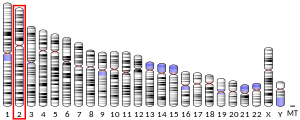GRIP and coiled-coil domain-containing protein 2 is a protein that in humans is encoded by the GCC2 gene.[4][5]
The protein encoded by this gene is a peripheral membrane protein localized to the trans-Golgi network. It is sensitive to brefeldin A. This encoded protein contains a GRIP domain which is thought to be used in targeting. Two alternatively spliced transcript variants encoding different isoforms have been described for this gene.[5]
References
edit- ^ a b c GRCh38: Ensembl release 89: ENSG00000135968 – Ensembl, May 2017
- ^ "Human PubMed Reference:". National Center for Biotechnology Information, U.S. National Library of Medicine.
- ^ "Mouse PubMed Reference:". National Center for Biotechnology Information, U.S. National Library of Medicine.
- ^ Luke MR, Kjer-Nielsen L, Brown DL, Stow JL, Gleeson PA (Feb 2003). "GRIP domain-mediated targeting of two new coiled-coil proteins, GCC88 and GCC185, to subcompartments of the trans-Golgi network". J Biol Chem. 278 (6): 4216–26. doi:10.1074/jbc.M210387200. PMID 12446665.
- ^ a b "Entrez Gene: GCC2 GRIP and coiled-coil domain containing 2".
Further reading
edit- Derby MC, Lieu ZZ, Brown D, et al. (2007). "The trans-Golgi network golgin, GCC185, is required for endosome-to-Golgi transport and maintenance of Golgi structure". Traffic. 8 (6): 758–73. doi:10.1111/j.1600-0854.2007.00563.x. PMID 17488291. S2CID 21624858.
- Beausoleil SA, Villén J, Gerber SA, et al. (2006). "A probability-based approach for high-throughput protein phosphorylation analysis and site localization". Nat. Biotechnol. 24 (10): 1285–92. doi:10.1038/nbt1240. PMID 16964243. S2CID 14294292.
- Reddy JV, Burguete AS, Sridevi K, et al. (2007). "A Functional Role for the GCC185 Golgin in Mannose 6-Phosphate Receptor Recycling". Mol. Biol. Cell. 17 (10): 4353–63. doi:10.1091/mbc.E06-02-0153. PMC 1635343. PMID 16885419.
- Hillier LW, Graves TA, Fulton RS, et al. (2005). "Generation and annotation of the DNA sequences of human chromosomes 2 and 4". Nature. 434 (7034): 724–31. Bibcode:2005Natur.434..724H. doi:10.1038/nature03466. PMID 15815621.
- Luke MR, Houghton F, Perugini MA, Gleeson PA (2005). "The trans-Golgi network GRIP-domain proteins form α-helical homodimers". Biochem. J. 388 (Pt 3): 835–41. doi:10.1042/BJ20041810. PMC 1183463. PMID 15654769.
- Derby MC, van Vliet C, Brown D, et al. (2005). "Mammalian GRIP domain proteins differ in their membrane binding properties and are recruited to distinct domains of the TGN". J. Cell Sci. 117 (Pt 24): 5865–74. doi:10.1242/jcs.01497. PMID 15522892.
- Gerhard DS, Wagner L, Feingold EA, et al. (2004). "The Status, Quality, and Expansion of the NIH Full-Length cDNA Project: The Mammalian Gene Collection (MGC)". Genome Res. 14 (10B): 2121–7. doi:10.1101/gr.2596504. PMC 528928. PMID 15489334.
- Ota T, Suzuki Y, Nishikawa T, et al. (2004). "Complete sequencing and characterization of 21,243 full-length human cDNAs". Nat. Genet. 36 (1): 40–5. doi:10.1038/ng1285. PMID 14702039.
- Lu L, Hong W (2004). "Interaction of Arl1-GTP with GRIP Domains Recruits Autoantigens Golgin-97 and Golgin-245/p230 onto the Golgi". Mol. Biol. Cell. 14 (9): 3767–81. doi:10.1091/mbc.E03-01-0864. PMC 196566. PMID 12972563.
- Strausberg RL, Feingold EA, Grouse LH, et al. (2003). "Generation and initial analysis of more than 15,000 full-length human and mouse cDNA sequences". Proc. Natl. Acad. Sci. U.S.A. 99 (26): 16899–903. Bibcode:2002PNAS...9916899M. doi:10.1073/pnas.242603899. PMC 139241. PMID 12477932.
- Krackhardt AM, Witzens M, Harig S, et al. (2002). "Identification of tumor-associated antigens in chronic lymphocytic leukemia by SEREX". Blood. 100 (6): 2123–31. doi:10.1182/blood-2002-02-0513. PMID 12200376.
- Eichmuller S, Usener D, Dummer R, et al. (2001). "Serological detection of cutaneous T-cell lymphoma-associated antigens". Proc. Natl. Acad. Sci. U.S.A. 98 (2): 629–34. doi:10.1073/pnas.021386498. PMC 14639. PMID 11149944.
- Scanlan MJ, Gordan JD, Williamson B, et al. (1999). "Antigens recognized by autologous antibody in patients with renal-cell carcinoma". Int. J. Cancer. 83 (4): 456–64. doi:10.1002/(SICI)1097-0215(19991112)83:4<456::AID-IJC4>3.0.CO;2-5. PMID 10508479. S2CID 21839750.
- Nagase T, Ishikawa K, Nakajima D, et al. (1997). "Prediction of the coding sequences of unidentified human genes. VII. The complete sequences of 100 new cDNA clones from brain which can code for large proteins in vitro" (PDF). DNA Res. 4 (2): 141–50. doi:10.1093/dnares/4.2.141. PMID 9205841.




